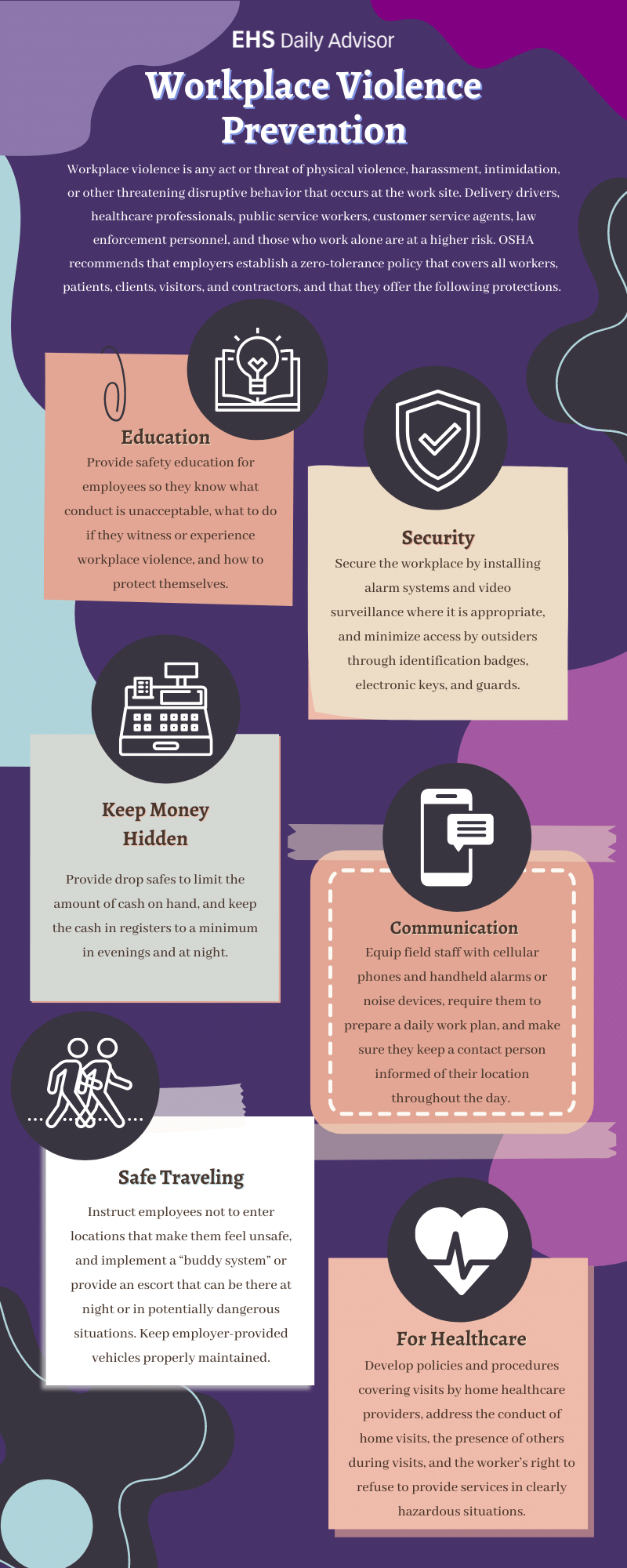Exactly how to Assess the Performance of Your California Workplace Violence Prevention Efforts
Exactly how to Assess the Performance of Your California Workplace Violence Prevention Efforts
Blog Article
The Role of Employee Training and Awareness in Enhancing Office Physical Violence Prevention Initiatives Across Different Industries
The integration of staff member training and understanding into work environment physical violence avoidance campaigns is increasingly acknowledged as an essential facet of business security throughout diverse industries. Recognizing these subtleties may expose approaches that can considerably enhance safety procedures and worker confidence in risky settings.
Importance of Training Programs
In today's dynamic job setting, the significance of training programs can not be overemphasized, especially in the context of work environment violence prevention. These programs function as a fundamental aspect in cultivating a secure and safe work environment society. By furnishing workers with the understanding and skills needed to determine, minimize, and react to potential risks, companies can promote an environment that focuses on safety and well-being.
Effective training programs do greater than merely instruct; they encourage employees to acknowledge caution signs of violence, understand the procedures for reporting cases, and create approaches to de-escalate possible disputes. In addition, they impart a sense of cumulative responsibility among personnel, motivating positive engagement in preserving a safe work environment.
Investment in training not just boosts staff member recognition but also demonstrates a company's commitment to securing its labor force. This proactive approach can bring about reduced incidents of work environment violence, lower absenteeism, and enhanced employee spirits. Eventually, extensive training programs are indispensable to developing a durable business culture that values safety and security and advertises a healthy and balanced workplace, thereby decreasing the risk of violence and its associated repercussions.
Secret Components of Effective Awareness
A comprehensive recognition program includes a number of key elements that are essential for efficiently preventing office violence. First, clear interaction of treatments and plans connected to office violence is crucial. Workers need to be educated concerning the organization's position on violence and the certain protocols in position for reporting events.
Second, training sessions need to include realistic circumstances that staff members might encounter. This sensible approach helps employees identify warning indications of possible physical violence and furnishes them with the required skills to de-escalate stressful scenarios. Third, cultivating an encouraging office culture is vital; employees should feel equipped to speak out without worry of revenge.
In addition, recurring education is very important to maintain recognition fresh and pertinent. Routine correspondence course and updates on arising dangers can enhance staff members' vigilance and preparedness. Including feedback mechanisms allows staff members to share their experiences and understandings, which can lead to continuous improvement of recognition initiatives. By integrating these components, companies can develop a durable framework for protecting against office violence, eventually adding to a safer and a lot more effective setting for all employees.
Industry-Specific Training Strategies
Effective office physical violence prevention training should be tailored to the one-of-a-kind challenges and risks dealt with by specific sectors. Healthcare environments require training that attends to the high chance of encounters with hostile patients or site visitors. Programs should concentrate on de-escalation techniques, acknowledging indication of prospective violence, and ensuring staff realize the significance of reporting events.
In comparison, retail settings may encounter various hazards, such as robbery or consumer disputes. Training in these environments ought to emphasize situational recognition, feedback procedures throughout emergency situations, and the relevance of protecting cash money and prized possessions.
Production and building sectors provide their own threats, typically connected with social problems or risky working problems. Training in these industries must consist of strategies for dispute resolution, promoting a society of safety, and motivating open communication amongst staff members.
Moreover, corporate offices may require training centered on protecting against harassment and bullying, promoting a respectful office society, and carrying out clear coverage mechanisms. Each industry should not just identify its details susceptabilities but likewise adapt training products to resonate with the labor force effectively, making certain that staff members really feel equipped and encouraged to deal with potential terrible scenarios.
Determining Educating Effectiveness
Examining the effect of workplace physical violence prevention training is vital for guaranteeing that workers are sufficiently prepared to handle potential hazards. To precisely measure training performance, organizations need to implement both quantitative and qualitative assessment techniques. Pre- and post-training studies can gauge changes in worker knowledge, mindsets, and behaviors worrying workplace physical violence. These studies need to concentrate on certain training purposes to make certain alignment with the company's objectives.
Furthermore, sensible analyses, such as role-playing circumstances or simulations, can provide understandings into just how well workers use found out abilities in real-life scenarios. Keeping track of occurrence records prior to and after training can also serve as an indicator of effectiveness, as a reduction in cases might mirror enhanced staff member preparedness.
Moreover, responses from individuals ought to be methodically collected to determine locations for enhancement in training material and shipment. Performing follow-up evaluations at routine intervals helps receive recognition and reinforces training concepts try this over time - california workplace violence prevention. By employing a thorough technique to gauging training effectiveness, companies can ensure that their workplace violence avoidance campaigns foster a safer atmosphere and boost general staff member wellness
Structure a Culture of Security

Training plays a critical function in this cultural change. Routine, comprehensive training sessions educate staff members about have a peek at these guys recognizing indication of office physical violence and the proper feedbacks. Motivating open communication permits staff members to voice worries without anxiety of revenge, promoting cumulative obligation for security.
In addition, integrating safety and security into everyday operations ensures that it ends up being a common worth instead of a simple conformity problem. This consists of normal safety drills, updates on plans, and feedback mechanisms that involve employees in safety discussions and improvements.
Ultimately, a robust culture of security not just alleviates the dangers of work environment physical violence however additionally enhances staff member morale and efficiency. By cultivating a setting where safety is an essential concern, organizations can produce durable offices that support both individual health and cumulative success.
Verdict
To conclude, worker training and awareness are vital elements in the prevention of workplace violence across numerous industries. Reliable training programs, customized to specific industry demands, enhance workers' capacity to identify and respond to possible dangers. By executing extensive understanding methods and promoting a culture of safety and security, companies can substantially minimize cases of workplace physical violence and improve overall employee morale. Dedication to recurring training and examination makes sure sustained efficiency and versatility in attending to emerging difficulties within the workplace atmosphere.

Routine, thorough training sessions inform employees about identifying caution indicators of work environment physical violence and the proper responses.In conclusion, employee training and recognition are vital components in the prevention of office violence across numerous industries.
Report this page